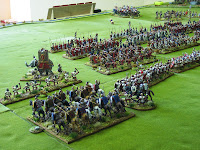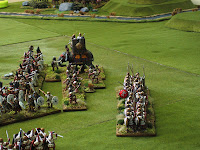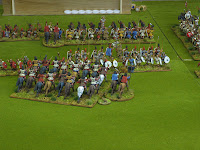Although I've messed about with Command and Colours the core mechanics have not changed beyond recognition. With these notes and a copy of Command and Colours you can follow what I did. The modifications gave the game a more conventional miniatures game feel - I'm an old stick in the mud at heart - rather just transposing the board game to the table.
Not all of the extra rules are my own invention, I picked up some playing a hex less game of Command and Colours at Sheffield Triples earlier this year.
For those who have asked for them, here are the modifications I used.
Table sectors, commands and activations
There are no table sectors. Instead, I divided each army into commands and gave each command a prefix - left, centre or right.
The units of each command have to be adjacent (within 3") to count as a single command. Units going beyond 3" go out of command, becoming a separate command, but maintaining the same 'sector' prefix. At the start of the battle this allows massed movement. As the battle goes on and units become detached command inevitably brakes down. It is possible to come back into an original command by closing the gap back to 3" or less (in our game this rarely happened)
When using command cards, the word 'unit' on the card is substituted with the word 'command'.
However, activating commands does not allow all of the units to 'battle'. Only the number of units stated on the card can do this.
For example:

On the Carthaginian left wing I have three commands, one is a single unit of elephants, one is a unit of Libyan spear men and one is a large unit (more anon) of Spanish cavalry, a large unit of Gallic cavalry and a normal sized unit of Numidian cavalry. All three commands are given the prefix 'left' - the prefix for these units never changes regardless of their position on the battlefield.
I use a 'order two units left' card: I can choose to move two commands. I choose to activate the command of elephants and the command of cavalry. As long as the cavalry units stay adjacently linked (within 3" of each other) they stay in command and can be activated on another card as if they are one unit.
After movement, all of the cavalry and the elephant are eligable to battle (in contact / range of the enemy. However, my command card is 'order 2 units left. Only two units can battle, so I choose the elephants and Spanish cavalry.
Movement
Light infantry including velites and catrati: 12"
Medium and heavy infantry: 8"
Warrior infantry: 8" / 12" (see C&C core rules).
Heavy and medium cavalry: 18"
Light cavalry: 24"
All evades: 12"
All units can wheel up to 90 degrees on their centre before movement.
All momentum advances are 8 inches straight ahead (no wheels).
Flank and rear attacks
To count flank / rear attack the attacking unit must start behind the flank rear at the beginning of the activation.
Versus flank: Attacker rolls normal dice. Defender rolls normal dice but only hits on appropriate coloured symbol.
Versus rear: Attacker rolls normal dice counting any flags as hits. Defender rolls only 2 dice and only hits on appropriate coloured symbol.
Ranges
Javelin armed skirmishers (includes Numidians, velites and catrati): 12"
Slingers: 18"
Special rules
Commands in manipular formation
Romans can form commands of hastati, principes and triarii. They form up in three seried ranks; hastai at the front, then princepes then triarii with a 2" gap between each, forming a column of units. Units within a manipular command can interpenetrate front to back (and vice versa) without penalty. It moves as a column of units, like 18C ships in line of succession.
In frontal combat, manipular commands may ignore all flags after the first if they still comprise at least two units. On receiving a flag, the front unit may retreat behind the next unit in the column, or behind the triarii, and be replaced in combat by the next unit of the command. The unit that moves forward may battle back if permitted to. Once the triarii are committed they cannot be replaced and the formation ceases to be manipular.
This backward and forward movement is used to allow the hastati and principes to support each other until, near collapse, it comes down, to coin a phrase, to the triarii.
If fighting with an enemy to its flank, it gains no manipular bonuses. The manipular formation was primarily a front to back formation.
Pilum or similar
Units armed with pilum or similar can discharge them at contact. At contact, roll 3 dice versus medium, heavy or warrior infantry, 1 dice versus other - hit on swords. If initiating 'battle' each sword adds a combat dice. If the unit is to 'battle back' each sword deducts a combat dice from the attacker. Mark the unit as 'unloaded'.
Strong units

These are represented by over strength wargames units. Extra strength should be represented by extra unit depth. Strong units at 150% can take an extra hit. Strong units at 200% can take two extra hits. Warrior units do not lose bonuses until they are reduced to 3 hits. Strong units do not get a combat dice adjustment.
Note: I use 4 stand units. A 150% unit has 6 stands in two ranks. A 200% unit has 8 stands in two ranks.
Small unit triarii
Triarii count only 3 hits before being destroyed.
Veterans
Veteran units can ignore 1 flag OR 1 sword hit. They bonus hit on ONE helmet.
Balearic slingers
Roll three combat dice in ranged combat.
Numidian cavalry
Numidian cavalry can 'snake' during movement provided they do not end their move in contact.
Velites and Catrati
Velites and catrati roll 3 dice for close combat and hit on swords. They may evade. They may interpenetrate and be interpenetrated by any friendly troops. Elephants roll only 2 dice versus velites and catrati.
Other light infantry and cavalry
Light infantry may interpenetrate and be interpenetrated by any friendly troops. Light cavalry may interpenetrate and be interpenetrated by other cavalry.
Out of ammo
Any unit engaging in ranged combat that rolls all helmets or swords can no longer engage in ranged combat.
Trebbia specials
Velites go 'out of ammo' on any double result.
All basic Roman close combat dice are reduced by 1. E.g. Heavy infantry roll 4 dice not 5. They are cold and have not had any Wheetabix.


















































